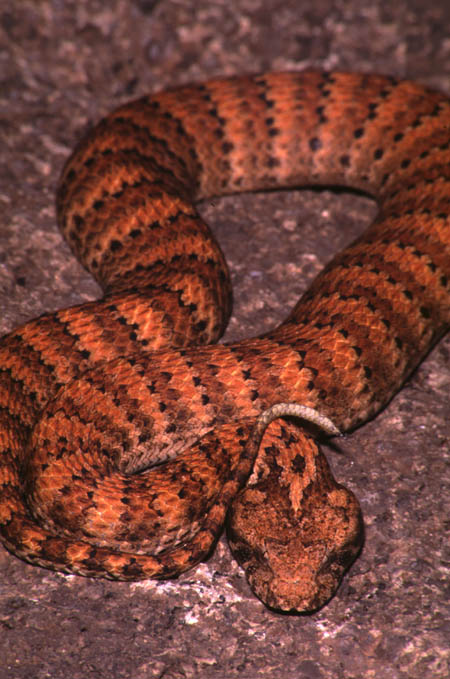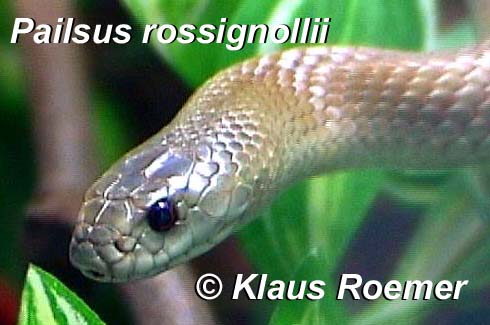|
A re-assessment of the taxonomy of the Red-bellied Black Snakes (Genus Pseudechis) with the descriptions of two new subspecies. |
Raymond Hoser
488 Park Road, Park Orchards, Victoria, 3134, Australia.
Phone: +61 3 9812 3322 Fax: 9812 3355 E-mail: SEE WEBSITE
Originally published in hard copy in May 2003 in Boydii:Journal of the Herpetological Society of Queensland Incorporated - Autumn Issue, pages 15-18.
This paper describes two new subspecies of Red-bellied Black Snake (Pseudechis porphyriacus), one from South-east South Australia and one from North-east Queensland.
INTRODUCTION
Following on from the taxonomy of Wells and Wellington (1985) who subdivided the genus Pseudechis as it was then known into the genera Pseudechis, Panacedechis and Cannia, which was also effectively adopted by Hoser (1998), the genus Pseudechis now contains just one known species, namely the Red-bellied Black-Snake (Pseudechis porphyriacus).
The species as is currently known has a distribution from the coastal areas of south-eastern South Australia, more-or-less continually along the coasts of Victoria, New South Wales and South-east Queensland (see further detail below).
The species is well-known and well-represented in both private (live) keepers collections and Museum collections in Australia and has been the subject of previous taxonomic studies, including Mackay (1955).
Mackay (1955) provided data that showed little trend differences in body scale counts and head scalation properties between the known regional populations.
This author has been fortunate enough to observe most regional variants in life and made cursory observations of some dead specimens held in some Australian museums.
It is evident that specimens from different parts of Australia vary widely between one another and distinction at the subspecific level at least is obvious.
A number of herpetologists, including Richard Wells (personal communication 1998) are of the view that the regional races should be described at the species level. Wells and Wellington (1985) said much the same thing when they wrote (on page 47):
'PSEUDECHIS Wagler, 1830
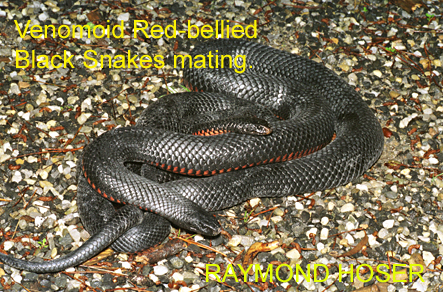
Pseudechis porphyriacus (Shaw, 1794). Herein regarded as a species complex.'
However in the absence of firm DNA or other data to this effect, this author has taken the most conservative approach and described the two apparently geographically isolated populations from far north Queensland and south-east South Australia as subspecies as opposed to full species.
It is likely that in the future both new subspecies named below will ultimately be elevated to the status of full species.
Specimens from both Victoria and South-east Queensland are evidently different in many respects to those from Sydney, which is where the type for the species Pseudechis porphyriacus presumably came from. However it appears that the differences may vary over a cline in the case of each and so for the time being all are treated as races of the same subspecies.
GENUS PSEUDECHIS WAGLER 1830
The Red-bellied Black Snake is an elapid snake (front-fanged venomous land snake), meaning that it possesses two large permanently erect fangs anchored to the top of the front of the mouth. When the mouth is closed these fangs rest in a pair of grooved slots on the buccal floor.
The genus Pseudechis are readily separated from all other Australian snakes by the following suite of characteristics.
The genus Pseudechis have a jet-black body and large eye.
They are generally separated from all other Australian elapids by their distinctive reddish-coloured belly.
In rare circumstances this species does not have a reddish coloured belly, it being either whitish, pinkish or even a steely grey or bluish colour (see descriptions of subspecies below).
Under these circumstances the species Pseudechis porphyriacus may be confused with other elapids.
If there is any confusion, then Pseudechis porphyriacus can be separated from all other Australian elapids on the basis of the following.
Pseudechis porphyriacus can be separated from Cryptophis nigrescens and other snakes of the genus Rhinoplocephalus by it's large versus small eye and having 17 versus 15 mid-body scale rows.
Pseudechis porphyriacus can be separated from snakes in the genus Panacedichis by the fact that it (always) has 17 instead of 19 mid-body rows.
Pseudechis porphyriacus can be separated from snakes of the genera Cannia and Pailsus by the fact that the latter either has a brownish colour dorsally, or if blackish, at least some of the dorsal scales have numerous light centres or tips.
Pseudechis porphyriacus can be readily separated from the genera Pseudonaja and Oxyuranus by the fact that about half or more of the subcaudals are single, whereas for the latter genera most or all of the subcaudals are divided.
Pseudechis porphyriacus do not have the large squarish frontal shield that characterizes all the Tiger Snakes (Genus Notechis), which may otherwise occasionally be confused with Pseudechis porphyriacus due to their sometimes dark colouring.
In Pseudechis porphyriacus, the frontal shield is more rhomboidal shaped, although the lateral sides of the scale are straight lined and the top and bottom are both triangular in shape (up and down the head).
Pseudechis porphyriacus can be readily separated from the genus Austrelaps by the fact that specimens of the latter have barring or white markings on the upper labials, whereas Pseudechis porphyriacus do not.
In parts of Victoria the two genera (Austrelaps and Pseudechis) are commonly confused by lay people because of the fact that Austrelaps commonly have an orangeish tinge on the lower sides of the ventral surface and the fact that specimens are often dark in colour.
It is now thought that most claims of Pseudechis porphyriacus from coastal south-west Victoria are in fact referable to the species Austrelaps superbus, as museum data do not show any Pseudechis porphyriacus from this area (refer to the map on page 45 of Coventry and Robertson (1991)).
There are no other Australian snakes with which Pseudechis porpyriacus could possibly be confused with due to vast differences in colour (alone) and other attributes..
According to Hoser (1989), for Pseudechis porphyriacus, the scales are smooth with 17 mid-body rows, 180-210 ventrals a divided (or sometimes single) anal and 40-65 subcaudals which are usually both single (anteriorly) and divided (posteriorly).
However there are some specimens which have all subcaudals single.
Adults usually range between 1.5 and 2 metres in length. Males grow slightly larger than females and male to male combat is known.
These snakes are usually, but not always found in proximity to water and/or in wetter habitats such as rainforests and gullies.
In line with all large elapids they are opportunistic feeders and eat almost any vertebrate large enough to fit in their mouths. Cannibalism has been recorded.
However the species Pseudechis porphyriacus is a known frog feeder (by preference) in the wild, and hence numbers have declined sharply in recent years due to the effects of Cane Toads (Bufo marinus) (Hoser 1987).
The snakes are common in the wild and often seen active during the day.
They are however easiest to find in winter when one can go to rubbish tips and similar types of places and find specimens seeking out warmth by hiding under sheets of tin, car doors and similar.
In the late 1970's when this author had a dog trained to find snakes by following scent trails, the dog found disproportionately large numbers of this species when in bushland throughout New South Wales as compared to other snake species (and was in fact eventually killed when he found and attacked a 1.5 metre specimen at Oxford Falls in New South Wales).
This indicates that the species gives off a stronger scent than most other elapids.
Mating is seasonal and breeding aggregations are known to occur (see Hoser (1980) for details.
Pseudechis porphyriacus are live-bearers, producing from 8-40 young (Mirtschin and Davis 1992).
In captivity, these snakes are hardy captives and readily feed on mice.
Juveniles may be a bit highly-strung and occasionally snappy, but adults tend to settle down to captivity well and are commonly "free handled" by their owners.
An example of this "free handling" is seen on the back cover of Hoser (1999).
As a rule, this author does not recommend "free handling" of highly venomous snakes.
The venom of Pseudechis porphyriacus has strong coagulant, haemolytic and cytotoxic actions. It is only weakly neurotoxic as compared to other dangerously venomous Australian species.
The bite is extremely painful to humans, but only rarely fatal.
The usual symptoms are extreme local pain and swelling, nausea and vomiting.
The initial dose of anti-venom usually given is either 3000 units of Tiger Snake (Notechis) antivenom or 6000 units of Black Snake antivenom (Mirtschin and Davis 1992).
There are numerous excellent publications dealing with all aspects of the species Pseudechis porphyriacus, including those listed on page 232 of Cogger et. al. (1983) and the sources cited within these as well.
PSEUDECHIS PORPHYRIACUS (SHAW, 1794)
- Known synonyms include:
- Coluber porphyriacus Shaw 1794: 27
- Pseudechis porphyriacus Wagler 1830
- Pseudechis porphyriacus is believed to be the first species of snake described from Australia.
Trimeresurus leptocephalus Lacepede 1804: 209
Acanthophis tortor Lesson 1830
Naja porphyrica Schlegel 1837: 479 (in error pro Coluber porphyriacus)
Trimeresurus porphyreus Dumeril and Bibron 1854: 1247
Pseudechis porphyraicus [sic] McCoy 1867 (in error pro Coluber porphyriacus)
Pseudechis porphyriacus Mackay 1955
While the holotype specimen for the species is presumed lost (see Cogger at. al. 1983), it is clear that it derives from Sydney or a nearby part of NSW as this was at the time the only part of Australia inhabited or collected from. The syntypes which are presumed lost are from "Port Jackson" (Sydney) and New South Wales (see for Acanthophis tortor Lesson 1830).
This author calls for a neotype to be designated as per the relevant rules of the ICZN's Code.
In line with the description given above for the genus, the subspecies Pseudechis poprhyriacus porphyriacus is herein restricted to the region stretching along the coastal strip from just north of Sydney to southern Victoria, and including adjacent inland areas.
The status of specimens from South-east Queensland is not certain.
Pseudechis porphyriacus from South-eastern South Australia and North Queensland are hereby assigned to two newly described subspecies.
PSEUDECHIS PORPHYRIACUS EIPPERI SUBSP. NOV.
HOLOTYPE
A specimen at the Australian Museum from Lake Barrine, Far North Queensland Lat.17°11' S, Long. 145°37' E (65 km southwest of Cairns). The specimen number is: R11333. It has 190 ventrals, a divided anal and 55 subcaudals.
DIAGNOSIS
This is the subspecies of Red-bellied Black Snake known from the Atherton Tableland and adjacent parts of North-east Queensland.
In general Pseudechis porphyriacus eipperi subsp. nov. is readily separated from Pseudechis porphyriacus porphyriacus by the fact that the ventral colouration is either pale pink or white ventrally as opposed to the more typical deep or crimson-red colour. The pink or whitish lower sides and ventralia is rare, but not unheard of for specimens from elsewhere.
Pseudechis porphyriacus eipperi subsp. nov. are not belived to attain sizes as large as Pseudechis porphyriacus porphyriacus with specimens 2 metres or more being regarded as rare.
Pseudechis porphyriacus eipperi subsp. nov. can also be separated from Pseudechis porphyriacus porphyriacus by distribution, with there being intermediate areas where neither subspecies occurs.
The subspecies Pseudechis porphyriacus eipperi subsp. nov. is believed to be confined to the Atherton Tableland and adjacent areas only. The status of Pseudechis porphyriacus from near Mackay in Queensland is not certain. This author believes that this population probably represents another undescribed subspecies.
Individuals of all Pseudechis porphyriacus subspecies can best be separated from one another with good accurate comparative DNA data.
Accurate known distribution information for the subspecies Pseudechis porphyriacus eipperi subsp. nov. is perhaps best shown in the map for the species Pseudechis porphyriacus as provided by Ingram and Raven (1991).
ETYMOLOGY
Named after Melbourne-based herpetologist Scott Eipper in honour of his various contributions to herpetology and in particular his involvement in day-to-day running of the Victorian Herpetological Society (VHS) following the stepping down of the long-term president, Brian Barnett in the late 1990's.
PSEUDECHIS PORPHYRIACUS RENTONI SUBSP. NOV.
HOLOTYPE
A specimen at the South Australian Museum, Adelaide, South Australia, reference number: 25056 from 5 km east of Tungkillo, Harrison Creek, South Australia, Australia, Lat. 34°49'S, Long 139°4'E (which is about 40 km east north-east of Adelaide, SA. in the hill country east of Adelaide).
PARATYPE
A specimen at the South Australian Museum, Adelaide, South Australia, reference number: 25097 from 5 km east of Tungkillo, Harrison Creek, South Australia, Australia, Lat. 34° 49' 0S, Long 139° 4' 0E (which is about 40 km east north-east of Adelaide, SA. in the hill country east of Adelaide).
DIAGNOSIS
Unlike the type subspecies Pseudechis porphyriacus porphyriacus from the Sydney area and also Victoria, most Pseudechis porphyriacus rentoni subsp. nov. seen by this author do not often have a brownish coloured rostral scale. In Pseudechis porphyriacus rentoni subsp. nov. the rostral is black like the rest of the dorsal surface of the snake, or if brownish, not as much as is usually seen in the subspecies Pseudechis porphyriacus porphyriacus.
Pseudechis porphyriacus rentoni subsp. nov. is a regionally large and thick-set variant of P. porphyriacus. In common with all other Pseudechis porphyriacus, Pseudechis porphyriacus rentoni subsp. nov. is readily identified by it's jet black dorsum and usually distinctive reddish coloured belly.
However Pseudechis porphyriacus rentoni subsp. nov. often has a distinctively organeish hue to the belly by comparison with specimens of the eastern subspecies which readily identifies the subspecies in many cases.
Some specimens of Pseudechis porphyriacus rentoni subsp. nov. are also known to have a steely-grey or even bluish coloured belly, both traits of which are unknown in the other subspecies of Pseudechis porphyriacus.
However because the traits cited above are not 100% consistent for all specimens of this subspecies, the best and simplest way to positively identify the subspecies Pseudechis porphyriacus rentoni subsp. nov. is with good and accurate distribution information.
Pseudechis porphyriacus rentoni subsp. nov. is restricted to South-eastern South Australia and is the only subspecies of Pseudechis porphyriacus rentoni found in that state.
There appears to be a gap in the distribution of Pseudechis porphyriacus in Western Victoria, with no specimens known from the far west of that state. This means that the two subspecies appear to be separated by distribution.
While some texts show Pseudechis porphyriacus being distributed across Western Victoria, either along the coastal strip and/or along the Murray River, anecdotal evidence suggests this is not so.
This author's own records show Copperheads (Austrelaps superbus), Tiger Snakes (Notechis scutatus and/or Notechis ater) and Brown Snakes (Pseudonaja textilis) as the only and dominant large elapids from the relevant parts of south-west Victoria along the coast.
Along the Murray River, which parallels (and consists of) Victoria's northern border, the later two genera dominate.
This situation is also shown as the case based on the holdings of dead specimens in the National Museum of Victoria in Melbourne as documented by Coventry and Robertson (1991), (see the map on p. 45).
Individuals of all Pseudechis porphyriacus subspecies can be separated from one another with good accurate comparative DNA data.
ETYMOLOGY
Named after Ian Renton, a local South Australian herpetologist who for many years has played a key role in educating children about snakes via his educational lecture program. Ian Renton has also provided specimens and data to numerous other herpetologists and also been tireless in his efforts to have snakes portrayed more favorably in the mainstream tabloid media, including the Rupert Murdoch controlled Adelaide Advertiser newspaper.
ACKNOWLEDGMENTS
Numerous people assisted over the previous three decades with the provision of live and dead specimens for study, access to and copies of relevant published papers and unpublished data.
Included here were the author’s immediate family (parents and wife), various employers who allowed the author leave to seek information and the countless herpetologists, curators, etc., all of whom gave the author unfettered access to both specimens and data.
Thanks are also due to the many people who inspected specimens on this author’s behalf and supplied relevant data.
REFERENCES CITED
Cogger, H. G., et. al. 1983, Zoological Catalogue of Australia: 1 Amphibia and Reptilia, Australian Government Printing Service, Canberra, ACT, Australia. 319 pp.
Coventry, A. J. and Robertson, P. 1991. The Snakes of Victoria: A guide to their identification., Department of Conservation and Environment, Victoria, 240 Victoria Parade, East Melbourne, Victoria, 3002:72 pp.
Hoser, R.T. 1980. 'Further records of aggregations of various species of Australian Snake', Herpetofauna, 12 (1), pp. 16-22.
Hoser, R. T. 1987. 'Cane Toad Threat to Australia's Wildlife', Herptile 12 (3) pp. 86-87 (also published in 1987 in Wildlife Australia, and Habitat).
Hoser, R. T. 1989. Australian Reptiles and Frogs, Pierson and Co., Sydney, NSW, Australia. 240 pp.
Hoser, R. T. 1998. A New Snake From Queensland, Australia (Serpentes: Elapidae). Monitor - Journal of the Victorian Herpetological Society 10 (1):5-9, 31.
Hoser, R. T. 1999. Victoria Police Corruption: The Book that the Victoria Police Don't Want You to Read, Kotabi Publishing, Doncaster, Victoria, Australia:736 pp.
Ingram, G. and Raven, R. (eds.) 1991. An atlas of Queensland’s Frogs, Reptiles, Birds and Mammals, Board of Trustees, Queensland Museum, Brisbane, Australia:391 pp.
Lacepede, B. G. E. 1804. 'Memoire sur plusiers animaux de la Nouvelle-Hollande dont la description n'a pas encore ete publiee.' Ann. Natl. Hist. Nat. Paris 4:184-211.
Lesson, R. P. 1829-1831. 'Description de quelques reptiles nouveaux ou peu connus.' In Duperrey, L. J. (ed.) (1826-1838) Voyage autor de monde, execute par ordre du Roi, sur la corvette de Sa Majeste, La Coquille, pendant les annees 1822, 1823, 1824 et 1825'. Zoologie 2(1):34-65 and Atlas (Reptiles pl 1-7) Paris.
Mackay, R. 1955. 'A revision of the genus Pseudechis', Proceedings of the Royal Zoological Society of New South Wales, 1953-1954:15-23.
McCoy, F. 1867. 'On the recent zoology and palaeontology of Victoria', Ann. Mag. Nat. Hist. (3) 20:175-202.
Mirtschin, P. and Davis, R. 1992. Dangerous Snakes of Australia (Revised Edition), Ure Smith Press, George Street, Sydney, NSW, 2000:208 pp.
Schlegel, H. 1837. Essai sur la physionomie des serpens, Partie Generale et Partie Descriptive. 2 Parts La Haye: Kips and Stockum.
Shaw, G. 1794. The Zoology of New Holland. Illustrated by J. Sowerby. London 33 pp.
Wagler J. G. 1830, Nat. Syst. Amph. Zoological Museum Univ. Munich
Wells, R. W. and Wellington, C. R. 1985. A classification of the Amphibia and Reptilia of Australia. Australian Journal of Herpetology, Supplementary Series, (1):1-61.
Worrell, E. 1972. Dangerous Snakes of Australia and New Guinea, Angus and Robertson, Sydney, NSW, Australia:71 pp.
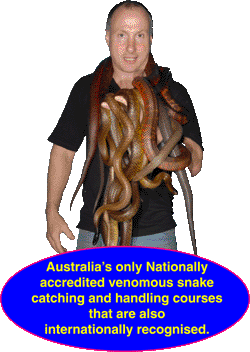
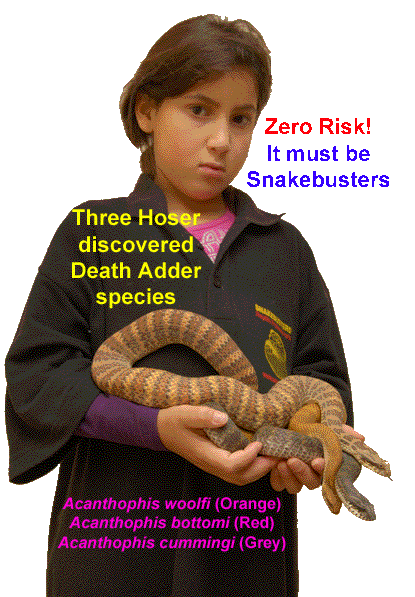
 To download the pdf (Acrobat) file of the
exact article as it appeared in the journal Boydii - click here - it will take up to 20 minutes to download with dial-up connections.
To download the pdf (Acrobat) file of the
exact article as it appeared in the journal Boydii - click here - it will take up to 20 minutes to download with dial-up connections.